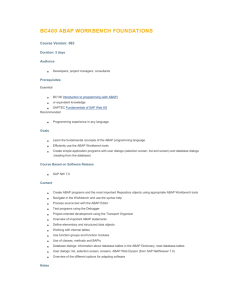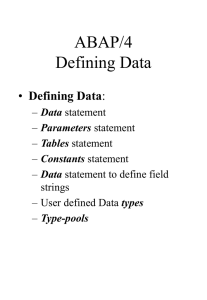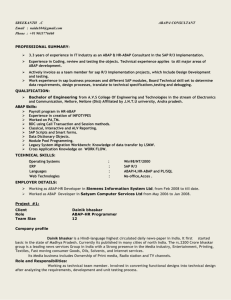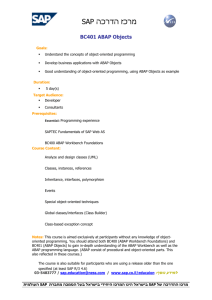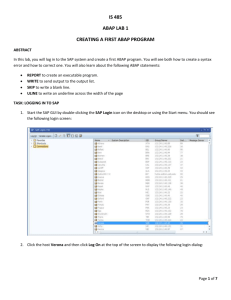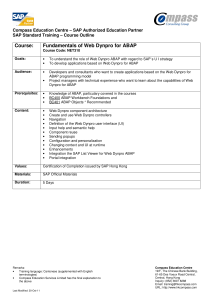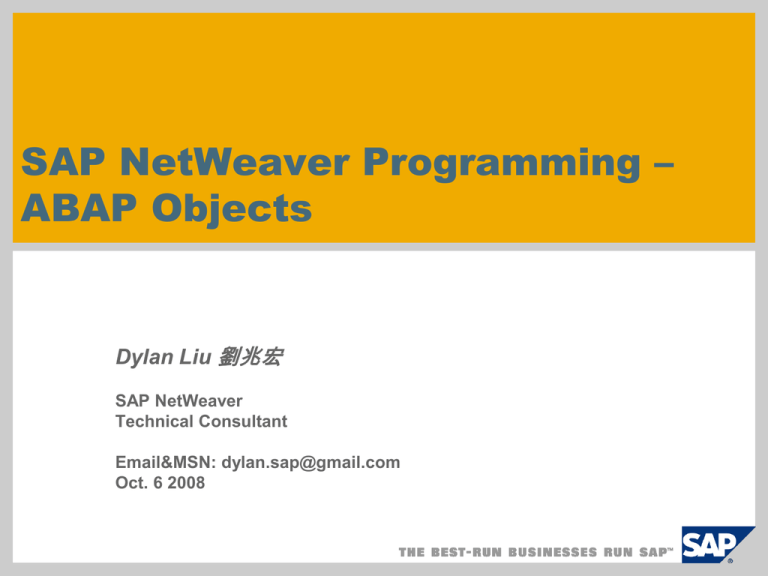
SAP NetWeaver Programming –
ABAP Objects
Dylan Liu 劉兆宏
SAP NetWeaver
Technical Consultant
Email&MSN: dylan.sap@gmail.com
Oct. 6 2008
SAP NetWeaver Programming – ABAP Objects
ABAP Objects:
Overview
Definition
ABAP
- Advanced Business Application Programming
- Is a historically grown 4GL language
- Is specialized for business applications
ABAP Objects
- Object-oriented extension of ABAP programming language
History
ABAP Programming Model
ABAP supports a hybrid programming model:
•
A object-oriented programming model that is based on
classes and interface of ABAP objects
• A procedural programming model that is based on
procedural calls and system event handling
• Both models are interoperable – you can call classes from
classic procedures, and you can call classic procedures
from methods.
SAP NetWeaver Programming – ABAP Objects
ABAP Objects:
Concept
Object-oriented Programming
Abstraction
- Ability to reflect real-world processes
- real-world modeled in classes and mapped in objects
Encapsulation
- Implementation details are hidden behind interfaces.
- Ensure that the abstract representation of an object is used only in accordance
with its specification.
Inheritance
- Abstractions derived from existing ones.
Instantiation
- Enables you to create multiple instances of a class.
Why use ABAP Objects?
•
ABAP Objects results in a clean and secure
programming style.
•
SAP delivers essential APIs (ex. Control
Framework) in object-oriented wrapped classes.
•
Most SAP new products are written in ABAP
Objects!
Object-oriented Programming Basics
•
Class is the model or the template
•
Object is an instance of class
•
Local class is created within any ABAP program
and only visible there
•
Global class is created with the Class Builder
tool and visible in any ABAP program
SAP NetWeaver Programming – ABAP Objects
ABAP Objects:
Keywords and Syntax
Define a CLASS
CLASS class_name DEFINITION.
....
ENDCLASS.
CLASS class_name IMPLEMENTATION.
....
ENDCLASS.
Visibility Section
Public
- All components are public and can be addressed by all
subclasses, the class itself and other external classes.
Protected
- Components of this section are protected and can only be
addressed by the class itself and the subclasses
Private
- Can only be used in the methods of the class itself
Define Visibility Section
CLASS class_name DEFINITION.
PUBLIC SECTION.
....
PROTECTED SECTION.
....
PRIVATE SECTION.
....
ENDCLASS.
Controlling the Instantiation
Public instantiation
- Allow to any user to create objects (default)
Protected instantiation
- Allow the creation of objects in methods of subclasses
Private instantiation
- Only the class itself can create objects
Define Instantiation
CLASS class_name
DEFINITION CREATE
PUBLIC | PROTECTED | PRIVATE.
ENDCLASS.
Components
Components of a class
1.
Attributes
2.
Methods
3.
Events
Components – Attribute
- The data objects within a class
- All data types of the ABAP type hierarchy can be
used
- ‘DATA’ statement is used for instance attributes
- ‘CLASS-DATA’ for static attribute
Define Attributes
CLASS attributes DEFINITION.
PRIVATE SECTION.
DATA objectValue TYPE i.
CLASS-DATA objectCount TYPE i.
ENDCLASS.
Components – Methods
- Processing block with a parameter interface
- Local data
- Instance method can access all attributes and
events
- Static method can access only static attributes and
events
Define Instance Methods
CLASS class_name DEFINITION.
PUBIC SECTION.
METHODS meth
IMPORTING
.. Ii TYPE type
EXPORTING .. Ei TYPE type ..
CHANGING
.. Ci TYPE type ..
EXCETPIONS .. Ei
ENDCLASS.
Define Static Methods
CLASS class_name DEFINITION.
PUBIC SECTION.
CLASS-METHODS class_meth
IMPORTING
.. Ii TYPE type
EXPORTING .. Ei TYPE type ..
CHANGING
.. Ci TYPE type ..
EXCETPIONS .. Ei
ENDCLASS.
Implementation of Methods
CLASS class_name DEFINITION.
METHOD meth.
…
ENDMETHOD.
ENDECLASS.
Components – Methods
Two special methods
constructor
- implicitly called for each instantiation of a new
object
- Execute by runtime environment.
class_constructor
– first time a class is accessed
Destructors
ABAP Objects does not provide any destructors
for application development.
Define Object Reference Variables
To create and access an object, object references
in reference variables are needed.
Syntax:
DATA ref TYPE REF TO class
Instantiating
Syntax:
CREATE OBJECT ref.
Different Selectors
Accessing fields of a structure
– Structure
component selector “-”
Accessing object components
– Object
component selector “->”
– Class component selector “=>”
– Interface component selector “~”
Use of Methods
Call instance method:
Syntax:
CALL METHOD oref->get_data.
Call class method:
Syntax:
CALL METHOD class=>get_data.
Functional Method
Functional method
Method
with any number of input parameters but only
one return value.
It can be used in operand positions for functions and
expressions.
Use of Functional Method
Functional method used in expressions:
Syntax
IF obj->functional_method( ) = abap_true.
…… do some thing
ENDIF.
Method Call
CALL METHOD oref->get_data.
CALL METHOD class=>get_data.
CALL METHOD oref->get_data
IMPORTING P1 = P1
RECEIVING P2 = P2.
Method Call Short Form
- Functional Method Call Style
oref->get_data( ).
class=>get_data( ).
P2 = oref->get_data( P1 ).
Special Reference Variables
The self-reference:
me
The superclass-reference(used in method call):
super
CLASS DEFINITION DEFERRED
CLASS - DEFERRED, LOAD
Syntax
CLASS class DEFINITION
DEFERRED | LOAD .
CLASS DEFINITION DEFERRED
CLASS c1 DEFINITION DEFERRED.
CLASS c2 DEFINITION.
PUBLIC SECTION.
DATA c1ref TYPE REF TO c1.
ENDCLASS.
CLASS c1 DEFINITION.
PUBLIC SECTION.
DATA c2ref TYPE REF TO c2.
ENDCLASS.
CLASS cl_gui_cfw DEFINITION LOAD.
DATA state LIKE cl_gui_cfw=>system_state.
Components – Events
- Allow the objects of a class to publish its status. Other
objects can then respond to the change in status.
1. Event trigger does not know the event handler.
2. Event trigger therefore does not initially
know if the event will even have an effect.
- Publish and Subscribe mechanism, i.e. Broadcasting
Event Triggers and Event Handlers
Trigger1
Raise Event
Trigger2
Raise Event
Handler1
Handler1
Terms
Events
Each method can trigger the events of its class
Handler methods
Methods can be declared as handler methods for events
Registering handlers
Objects for an event can be registered at runtime as handlers
for the objects of the classes which can trigger the event
Define Events
CLASS raising_class DEFINITION.
PUBLIC SECTION.
EVENTS: raised_event.
ENDCLASS.
Raise Events
CLASS raising_class IMPLEMENTATION.
METHOD raising_method.
RAISE EVENT raised_event.
ENDMETHOD.
ENDCLASS.
Define Handler Methods
CLASS handler_class DEFINITION.
PUBLIC SECTION.
METHODS: handler_method FOR EVENT
raised_event OF raising_class.
ENDCLASS.
Handler Methods
CLASS handler_class IMPLEMENTATION.
METHOD handler_method.
… some logics here
ENDMETHOD.
ENDCLASS.
Register Handlers
SET HANDLER
handler_instance->handler_method
FOR ALL INSTANCES.
SET HANDLER
handler_instance->handler_method
FOR handled_instance.
SAP NetWeaver Programming – ABAP Objects
ABAP Objects:
Exception Handling
Exception Handling
Exceptions are events that arise during the execution
of an ABAP program at which the program is
interrupted, because it is not possible to continue
processing the program in a meaningful way.
Exceptions are either treatable or untreatable.
Exception Handling
Runtime Errors
Exceptions Before Release 6.10
Class-Based Exceptions
Runtime Errors
Exception that was not handled
data RESULT type I.
RESULT = 1 / 0.
Runtime Errors
Shortdump screenshot
Exceptions Before Release 6.10
Handling exceptions as catchable runtime errors
data RESULT type I.
catch system-exceptions ARITHMETIC_ERRORS = 4.
RESULT = 1 / 0.
endcatch.
if SY-SUBRC = 4.
...
endif.
Class-Based Exceptions
Handling exceptions using/with exception classes
data MYREF type ref to CX_SY_ARITHMETIC_ERROR.
data ERR_TEXT type STRING.
data RESULT type I.
try.
RESULT = 1 / 0.
catch cx_sy_arithmetic_error into MYREF.
ERR_TEXT = MYREF->GET_TEXT( ).
endtry.
Defining Exceptions
All exception classes must inherit from the common
superclass CX_ROOT and one of its subordinate
classes:
·
·
·
CX_STATIC_CHECK
CX_DYNAMIC_CHECK
CX_NO_CHECK
Propagating Exceptions
The RAISING addition is specified in the declaration of
a method / subroutine:
METHODS meth ... RAISING cx_... cx_...
FORM form ... RAISING cx_... cx_...
SAP NetWeaver Programming – ABAP Objects
Use of ABAP Objects:
Advanced Concept
Advanced Concept of Object-oriented
Programming
Inheritance
Interface
Friend
Inheritance
Superclass
Generalization
Animal
dog
cat
Subclass
Specialization
Visibility in Inheritance
Public - contains all the public components of all
superclasses and its own added public components.
Protected - Contains all the protected components of
all superclasses as well as its own.
Private - Contains its own private components.
Address by its own methods.
Method Redefinition
Re-implement the method of supper class
In Class declaration part:
Syntax:
METHODS meth REDEFINITION.
Up Cast
Up Cast (Also referred to as widening cast)
- Assignment between reference variables, where the
static type of the target variables is similar or
identical to the static type of the source variables.
Casting operator
= or MOVE ... TO … .
Down Cast
Down Cast (Also called a narrowing cast)
- an assignment between reference variables in which
the static type of the target variable more specific
than the static type of the source variable.
Casting operator
?= or MOVE ... ?TO … .
Abstract Classes and Methods
When needed a class model for subclasses and
do not require any objects from this class.
Abstract Class
Syntax:
CLASS class DEFINITION ABSTRACT.
…
ENDCLASS
Abstract Method
CLASS class DEFINITION ABSTRACT.
PUBLIC SECTION.
METHODS: method ABSTRACT.
ENDCLASS.
Final Classes and Methods
When needed to protect a class or individual
method from uncontrolled specialization
Final Class
Syntax:
CLASS class DEFINITION FINAL.
…
ENDCLASS
Final Method
Syntax:
CLASS class DEFINITION FINAL.
PUBLIC SECTION.
METHODS: method FINAL.
ENDCLASS
Constructors in Inheritance
Must always take the definition of the
superclasses into account
METHOD constructor.
CALL METHOD super->constructor.
ENDMETHOD.
Interface
- Describes the public visibility section of a
given class without itself implementing
functionality.
- Are defined either locally or globally in the
class library.
Define Interface
INTERFACE intf.
DATA …
CLASS-DATA ..
METHODS …
CLASS-METHODS …
EVENTS …
CLASS-EVENTS…
ENDINTERFACE.
Implement Interfaces in Classes
CLASS class DEFINITION.
PUBLIC SECTION.
…
INTERFACES: intf1, intf2 …
…
ENDCLASS.
Interfaces are incorporated solely in the public
visibility section of a class.
Interface Implementation in Classes
Class must implement all the methods of all
incorporated interfaces in its implementation part.
CLASS class IMPLEMENTATION.
…
METHOD intf1~ method…
…
ENDMETHOD.
ENDCLASS.
Composing Interfaces
INTERFACE intf1.
METHODS meth.
ENDINTERFACE.
INTERFACE intf2.
INTERFACES intf1.
METHODS meth.
ENDINTERFACE.
Composing Interfaces
CLASS class DEFINITION.
PUBLIC SECTION.
INTERFACES intf2.
ENDCLASS.
CLASS class IMPLEMENTATION.
METHOD intf1~meth. … ENDMETHOD.
METHOD intf2~meth….. ENDMETHOD.
ENDCLASS.
Alias Names for Interface Component
Syntax
CLASS class DEFINITION.
PUBLIC SECTION.
INTERFACES intf.
ALIASES name FOR intf~comp.
…
ENDCLASS.
Alias Names for Interface Component
Example:
CALL METHOD oref~intf->method.
=
CALL METHOD oref->alias.
Friend
The additions FRIENDS of statement CLASS define
other classes or interfaces as friends of the class
and thus grant them access to their protected and
private components.
Friend
The additions FRIENDS of statement CLASS define
other classes or interfaces as friends of the class
and thus grant them access to their protected and
private components.
Friend - Example
INTERFACE i1.
…
ENDINTERFACE.
CLASS c1 DEFINITION CREATE PRIVATE FRIENDS i1.
PRIVATE SECTION.
DATA a1 TYPE c LENGTH 10 VALUE 'Class 1'.
ENDCLASS.
CLASS c2 DEFINITION.
PUBLIC SECTION.
INTERFACES i1.
METHODS m2.
ENDCLASS.
Friend - Example
CLASS c2 IMPLEMENTATION.
METHOD m2.
DATA oref TYPE REF TO c1.
CREATE OBJECT oref.
WRITE oref->a1.
ENDMETHOD.
ENDCLASS.
SAP NetWeaver Programming – ABAP Objects
ABAP Objects:
ABAP Workbench Tool
Class Builder
Global class is created with the Class Builder tool and
visible in any ABAP program.
Class Builder is a special maintenance tool in ABAP
Workbench
Class Builder
TCode: SE24 / SE80
SAP NetWeaver Programming – ABAP Objects
Use of ABAP Objects:
OO Transaction
OO Transactions
In transaction maintenance (SE93), you can
specify a transaction code as an OO
transaction.
OO Transactions
OO Transactions
SAP NetWeaver Programming – ABAP Objects
ABAP Objects for Java Programmer
Similarities Between Java and ABAP
Like Java,
•
ABAP is a programming language
•
ABAP is object-oriented
•
ABAP runs on a virtual machine
•
ABAP is the foundation for a whole
technology
Similarities - Typical Java Development
Tool
Similarities – ABAP Development Tool
Similarities - Classes
Syntactical differences aside, ABAP supports classes as Java does
In ABAP, the declaration and implementation of a class are split into
separate parts
Similarities - Classes
Syntactical differences aside, ABAP supports attributes and methods as
Java does (apart from method name overloading)
In ABAP, a class has three visibility sections (PUBLIC, PROTECTED,
PRIVATE)
Similarities – Method Implementations
For basic operations, syntax can be translated almost one to one
•
”->” (or ”-”) replaces ”.”, ”.” replaces ”;”, ”me” replaces ”this”
•
In ABAP, blocks are built by keywords instead of {}
•
Raising exceptions follows the same principles
Similarities – Exceptions and Inheritance
Exception classes must be derived from predefined superclasses
The superclasses define how exception handling is checked
Similarities – Handling Objects in Java
Similarities – Handling Objects in ABAP
Similarities – Keywords 1
Similarities – Keywords 2
SAP NetWeaver Programming – ABAP Objects
Use of ABAP Objects:
The Control Framework
The Control Framework (CFW)
In the SAP system, you can use ABAP to control
desktop applications (custom controls).
The application logic runs on the SAP application
server, which drives the custom control at the
frontend.
The Control Framework supports controls (ActiveX
and JavaBeans) that are implemented within the
SAP GUI.
CFW – HTML Control
CFW – Picture Control
CFW – ALV Grid Control
Control Framework Architecture
Global class in the class library for each GUI
control supplied and that when working with
GUI controls, for each control object on the
frontend there is a proxy object of the
corresponding class in the ABAP programs.
Control Framework Architecture
ABAP programming works only with the proxy objects
The CFW forwards its method calls to actual GUI control objects and informs
the objects of the ABAP program by triggering events about the user
actions on the GUI controls.
Control Framework Architecture
Control Framework Example
Container Controls
CL_GUI_CUSTOMER_CONTAINER
CL_GUI_DOCKING_CONTAINER
CL_GUI_SPLITTER_CONTAINER
CL_GUI_DIALOGBOX_CONTAINER
Application Controls
CL_GUI_TOOLBAR
CL_GUI_PICTURE
CL_GUI_HTML_VIEWER
CL_GUI_TEXTEDIT
CL_GUI_SIMPLE_TREE
CL_GUI_ALV_GRID
Enjoy Demo Center
TCode: DWDM
SAP NetWeaver Programming – ABAP Objects
Use of ABAP Objects:
BAdIs
Enhancement using Business Add-Ins
Business Add-Ins (BAdIs) are one of the most
important technologies used to adapt SAP software
to specific requirements.
Business Add-Ins: Architecture
Implementation of Business Add-Ins
SAP NetWeaver Programming – ABAP Objects
Use of ABAP Objects:
Web Programming
Web Programming
•
BSP
•
Web Dynpro for ABAP
•
Custom HTTP Handler Class
•
…
SAP Netweaver Programming ABAP
Q&A
Copyright 2008 SAP AG. All Rights Reserved
No
part of this publication may be reproduced or transmitted in any form or for any purpose without the express
permission of SAP AG. The information contained herein may be changed without prior notice.
Some
software products marketed by SAP AG and its distributors contain proprietary software components of other
software vendors.
Microsoft®,
WINDOWS®, NT®, EXCEL®, Word®, PowerPoint® and SQL Server® are registered trademarks of
Microsoft Corporation.
IBM®,
DB2®, DB2 Universal Database, OS/2®, Parallel Sysplex®, MVS/ESA, AIX®, S/390®, AS/400®, OS/390®,
OS/400®, iSeries, pSeries, xSeries, zSeries, z/OS, AFP, Intelligent Miner, WebSphere®, Netfinity®, Tivoli®, Informix and
Informix® Dynamic ServerTM are trademarks of IBM Corporation in USA and/or other countries.
ORACLE®
UNIX®,
is a registered trademark of ORACLE Corporation.
X/Open®, OSF/1®, and Motif® are registered trademarks of the Open Group.
Citrix®,
the Citrix logo, ICA®, Program Neighborhood®, MetaFrame®, WinFrame®, VideoFrame®, MultiWin® and other
Citrix product names referenced herein are trademarks of Citrix Systems, Inc.
HTML,
DHTML, XML, XHTML are trademarks or registered trademarks of W3C®, World Wide Web Consortium,
Massachusetts Institute of Technology.
JAVA®
is a registered trademark of Sun Microsystems, Inc.
JAVASCRIPT®
is a registered trademark of Sun Microsystems, Inc., used under license for technology invented and
implemented by Netscape.
MarketSet
SAP,
and Enterprise Buyer are jointly owned trademarks of SAP AG and Commerce One.
R/3, mySAP, mySAP.com, xApps, xApp, SAP NetWeaver and other SAP products and services mentioned herein
as well as their respective logos are trademarks or registered trademarks of SAP AG in Germany and in several other
countries all over the world. All other product and service names mentioned are the trademarks of their respective
companies. Data contained in this document serves information purposes only. National product specifications may vary.

